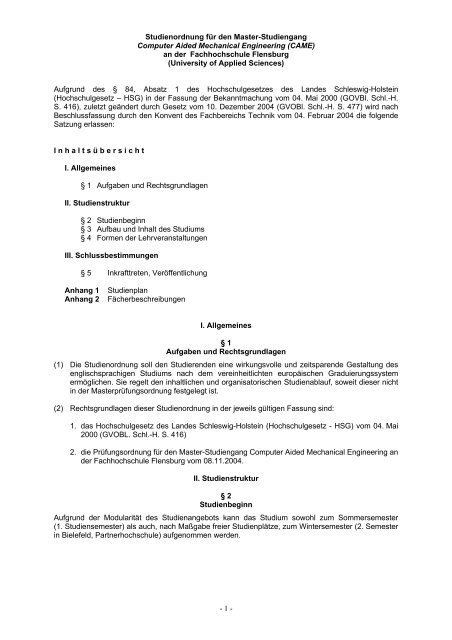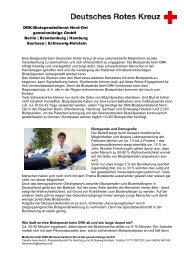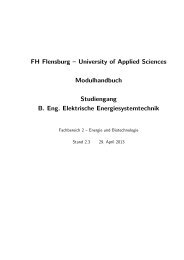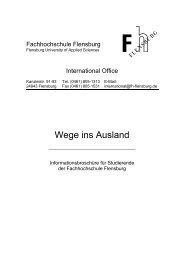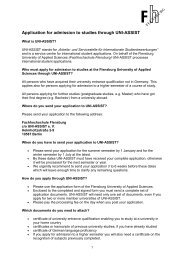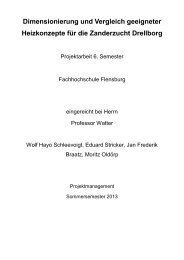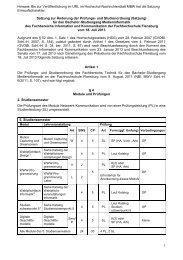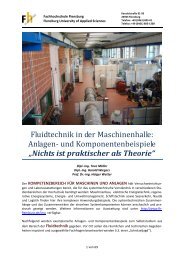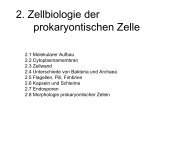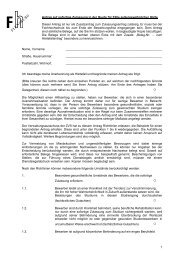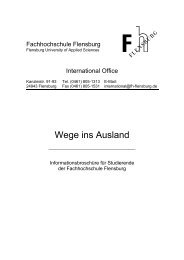- 1 - Studienordnung für den Master-Studiengang Computer Aided ...
- 1 - Studienordnung für den Master-Studiengang Computer Aided ...
- 1 - Studienordnung für den Master-Studiengang Computer Aided ...
You also want an ePaper? Increase the reach of your titles
YUMPU automatically turns print PDFs into web optimized ePapers that Google loves.
<strong>Studienordnung</strong> <strong>für</strong> <strong>den</strong> <strong>Master</strong>-<strong>Studiengang</strong><br />
<strong>Computer</strong> <strong>Aided</strong> Mechanical Engineering (CAME)<br />
an der Fachhochschule Flensburg<br />
(University of Applied Sciences)<br />
Aufgrund des § 84, Absatz 1 des Hochschulgesetzes des Landes Schleswig-Holstein<br />
(Hochschulgesetz – HSG) in der Fassung der Bekanntmachung vom 04. Mai 2000 (GOVBl. Schl.-H.<br />
S. 416), zuletzt geändert durch Gesetz vom 10. Dezember 2004 (GVOBl. Schl.-H. S. 477) wird nach<br />
Beschlussfassung durch <strong>den</strong> Konvent des Fachbereichs Technik vom 04. Februar 2004 die folgende<br />
Satzung erlassen:<br />
I n h a l t s ü b e r s i c h t<br />
I. Allgemeines<br />
§ 1 Aufgaben und Rechtsgrundlagen<br />
II. Studienstruktur<br />
§ 2 Studienbeginn<br />
§ 3 Aufbau und Inhalt des Studiums<br />
§ 4 Formen der Lehrveranstaltungen<br />
III. Schlussbestimmungen<br />
§ 5 Inkrafttreten, Veröffentlichung<br />
Anhang 1 Studienplan<br />
Anhang 2 Fächerbeschreibungen<br />
I. Allgemeines<br />
§ 1<br />
Aufgaben und Rechtsgrundlagen<br />
(1) Die <strong>Studienordnung</strong> soll <strong>den</strong> Studieren<strong>den</strong> eine wirkungsvolle und zeitsparende Gestaltung des<br />
englischsprachigen Studiums nach dem vereinheitlichten europäischen Graduierungssystem<br />
ermöglichen. Sie regelt <strong>den</strong> inhaltlichen und organisatorischen Studienablauf, soweit dieser nicht<br />
in der <strong>Master</strong>prüfungsordnung festgelegt ist.<br />
(2) Rechtsgrundlagen dieser <strong>Studienordnung</strong> in der jeweils gültigen Fassung sind:<br />
1. das Hochschulgesetz des Landes Schleswig-Holstein (Hochschulgesetz - HSG) vom 04. Mai<br />
2000 (GVOBL. Schl.-H. S. 416)<br />
2. die Prüfungsordnung <strong>für</strong> <strong>den</strong> <strong>Master</strong>-<strong>Studiengang</strong> <strong>Computer</strong> <strong>Aided</strong> Mechanical Engineering an<br />
der Fachhochschule Flensburg vom 08.11.2004.<br />
II. Studienstruktur<br />
§ 2<br />
Studienbeginn<br />
Aufgrund der Modularität des Studienangebots kann das Studium sowohl zum Sommersemester<br />
(1. Studiensemester) als auch, nach Maßgabe freier Studienplätze, zum Wintersemester (2. Semester<br />
in Bielefeld, Partnerhochschule) aufgenommen wer<strong>den</strong>.<br />
- 1 -
§ 3<br />
Aufbau und Inhalt des Studiums<br />
(1) Der <strong>Studiengang</strong> <strong>Computer</strong> <strong>Aided</strong> Mechanical Engineering mit dem zugehörigen<br />
<strong>Master</strong>abschluss (MSc) wird an der FH Flensburg in Zusammenarbeit mit einer vertraglichen<br />
Partnerhochschule angeboten. Beide Partner stimmen ihr Angebot aufeinander ab.<br />
(2) Die Regelstudienzeit <strong>für</strong> das <strong>Master</strong>studium beträgt drei Semester. Es besteht aus zwei<br />
Studiensemestern und einer <strong>Master</strong>arbeit (Thesis), deren Bearbeitungsdauer fünf Monate beträgt<br />
und in englischer Sprache zu verfassen ist. Die <strong>Master</strong>arbeit kann wahlweise an der FH<br />
Flensburg oder an der Partnerhochschule durchgeführt wer<strong>den</strong>.<br />
(3) Der Studienumfang beträgt insgesamt 82 Semesterwochenstun<strong>den</strong>.<br />
(4) Das Lehrangebot umfasst die folgen<strong>den</strong> Pflichtmodule (V=Vorlesung, P=Praktikum, Pa=<br />
Projektarbeit):<br />
a) Im Sommersemester:<br />
SS 1 Finite Element Method - Dynamics and Field Problems (3V, 3P)<br />
SS 2 Advanced <strong>Computer</strong> <strong>Aided</strong> Design - Mathematical Aspects (3V, 3P)<br />
SS 3 Computational Fluid Dynamics (3V, 3P)<br />
SS 4 Data Management (3V, 3P)<br />
SS 5 Projektarbeit (6Pa)<br />
b) Im Wintersemester:<br />
WS 1 <strong>Computer</strong> <strong>Aided</strong> Engineering – Application and Programming (3V, 3P)<br />
WS 2 Dynamics of Machines and Structures (3V, 3P)<br />
WS 3 Finite Element Method – Design Optimization (3V, 3P)<br />
WS 4 Computational Signal Processing (3V, 3P)<br />
WS 5 Projektarbeit (6 Pa)<br />
Das Lehrangebot wird zur Hälfte von der Partnerhochschule erbracht.<br />
(5) Wahlmodule können nach Maßgabe der Dozentinnen oder der Dozenten angeboten wer<strong>den</strong>.<br />
Darüber hinaus wird im Wintersemester im Umfang von 2 SWS eine Sprachausbildung<br />
angeboten.<br />
(6) Der Studienplan ergibt sich aus Anlage 1; die Modulbeschreibungen sind in Anlage 2 enthalten.<br />
Die Anlagen sind Bestandteil der <strong>Studienordnung</strong>.<br />
§ 4<br />
Formen der Lehrveranstaltungen<br />
(1) Vorlesungen (V): Zusammenhängende Darstellung eines Lehrstoffes, Vermittlung von Fakten<br />
und Metho<strong>den</strong> durch die Lehren<strong>den</strong>.<br />
(2) Praktikum (P): Erwerben und Vertiefen von Kenntnissen durch Bearbeitung praktischer oder<br />
experimenteller Aufgaben. Die Lehren<strong>den</strong> leiten die Studieren<strong>den</strong> an und überwachen die<br />
Veranstaltung. Die Studieren<strong>den</strong> führen praktische Arbeiten und Versuche durch.<br />
(3) Projektarbeit (Pa): Ingenieurmäßiges Bearbeiten und Lösen von technischen Problemstellungen<br />
- 2 -
III. Schlussbestimmungen<br />
§ 5<br />
In-Kraft-Treten, Veröffentlichung<br />
Diese <strong>Studienordnung</strong> tritt am Tage nach ihrer Veröffentlichung in Kraft.<br />
Flensburg , <strong>den</strong> 31.01.2005<br />
Fachhochschule Flensburg<br />
Fachbereich Technik<br />
- Der Dekan -<br />
gez. Prof. Dr. Helmut Erdmann<br />
- 3 -
Anlage 1 zur <strong>Studienordnung</strong> <strong>Master</strong>-<strong>Studiengang</strong> <strong>Computer</strong> <strong>Aided</strong> Mechanical Engineering<br />
Studienplan<br />
Modulübersicht<br />
Sommersemester<br />
Kreditpunkte (CRP) SWS<br />
nach ECTS<br />
SS 1 Finite Element Method – 6 6<br />
Dynamics and Field Problems (FEM-DF)<br />
SS 2 Advanced <strong>Computer</strong> <strong>Aided</strong> Engineering –<br />
Mathematical Aspects (ACAD)<br />
6 6<br />
SS 3 Computational Fluid Dynamics (CFD) 6 6<br />
SS 4 Data Management (DM) 6 6<br />
SS 5 Projektarbeit (Pa) 6 6<br />
--------- ----------<br />
30 30<br />
Wintersemester<br />
WS 1 <strong>Computer</strong>-<strong>Aided</strong> Engineering – Applicat. and Program. (CAE-AP) 6 6<br />
WS 2 Dynamics of Machines and Stuctures (DMS) 6 6<br />
WS 3 Finite Element Method – Design Optimization (FEM-DO) 6 6<br />
WS 4 Computational Signal Processing (CSP) 6 6<br />
WS 5 Projektarbeit (Pa) 6 6<br />
---------- ---------<br />
30 30<br />
Weitere Veranstaltungen (Vorkurse, Zusatzkurse)<br />
11. Fremdsprachen - (2)<br />
12. Einführungskurs Deutsch<br />
3. Studiensemester (je nach Beginn SS oder WS)<br />
13. <strong>Master</strong>arbeit (Thesis) 30 (23+7) 30<br />
30<br />
Gesamt 90 90(+2)<br />
Sommersemester<br />
Technische Module<br />
FEM –<br />
Dynamics<br />
and Field<br />
Problems<br />
ACAD –<br />
Mathematical<br />
Aspects<br />
6 CRP<br />
Winter-<br />
6 CRP<br />
<strong>Computer</strong> Dynamics of.<br />
semester <strong>Aided</strong> Eng.<br />
Appl a. Prog.<br />
Mach. a. Str.<br />
6 CRP 6 CRP<br />
3. 23 CRP<br />
Studien- Thesis<br />
semester +<br />
07 CRP<br />
Kolloquium<br />
∑ 30 CRP<br />
Computat.<br />
Fluid<br />
Dynamics<br />
6 CRP<br />
FEM -<br />
Design Optim.<br />
6 CRP<br />
- 4 -<br />
Data<br />
Management<br />
6 CRP<br />
Computat.<br />
Signal Proc.<br />
6 CRP<br />
Fachübergreifende Module<br />
Projekt-<br />
Arbeit<br />
6 CRP<br />
Projekt-<br />
Arbeit<br />
6 CRP<br />
Fremdsprachen<br />
--
Anlage 2 zur <strong>Studienordnung</strong> <strong>Master</strong>-<strong>Studiengang</strong> <strong>Computer</strong> <strong>Aided</strong> Mechanical Engineering<br />
Fächerbeschreibung<br />
Gesamtbemerkungen zur Durchführung der Übungen, der Projektarbeiten und der Thesis<br />
Ein wesentlicher Aspekt bei der Durchführung des <strong>Master</strong>-Studiums ist die Stärkung, Vermittlung und<br />
der methodischer Einsatz von Zusatzqualifikationen, die insbesondere<br />
- das methodisch-analytische Denken stärken, und gleichzeitig die Kreativität, Innovativität und<br />
Flexibilität fördern,<br />
- die systematische Findung von Problemlösungen und deren Umsetzung durch zielgerichtete<br />
Arbeits- und Problemlösungstechniken fördern,<br />
- rhetorische Fähigkeiten bei der Darstellung und Vermittlung des erarbeitetem Stoffes aus- und<br />
weiterbil<strong>den</strong>, sei es einzeln oder in kleinen Gruppen in kurzen Übungsvorträgen, insbesondere<br />
aber auch in Form der Projektarbeiten und der Abschlussarbeit (<strong>Master</strong> Thesis), wobei<br />
letztere als öffentlicher Vortrag zu halten ist. Die rhetorischen Fähigkeiten wer<strong>den</strong> u.a. im<br />
Modul 11 (Fremdsprachen) methodisch und didaktisch geschult.<br />
- die Bereitschaft und Fähigkeit in Gruppen zu arbeiten fördern, die dort auftreten<strong>den</strong> Konflikte<br />
zu lösen und durch interdisziplinäre Ansätze wesentlich zur Zeit- und Kostenersparnis<br />
beizutragen.<br />
- die Bereitschaft zur Übernahme von Verantwortung in Form von Projektleitungen zu üben.<br />
Durch gezielte Auswahl von Übungsaufgaben sollen alle diese Zusatzqualifikationen eingeübt und<br />
vertieft wer<strong>den</strong>. Die Projektarbeiten sind in Form eines Vortrages mit medialer Unterstützung vor der<br />
gesamten Gruppe zu präsentieren und zu verteidigen.<br />
Die Thesis ist in einem öffentlich Vortrag von 30 Min. Dauer zu präsentieren und zu verteidigen.<br />
Anm.: Das abschließende Kolloquium ist nicht öffentlich.<br />
MSc-<strong>Studiengang</strong> CAME FH Flensburg<br />
Sommersemester<br />
Modul SS 1<br />
Finite Element Methods - Dynamics and Field Problems<br />
In many fields of engineering and quantitative science the Finite Element Method (FEM) is the method<br />
of choice when it comes to analysing field problems which are governed by partial differential<br />
equations with complicated boundary conditions. Originally developed to solve static problems in<br />
mechanical and civil engineering, the FEM has greatly enhanced its scope and has become the basis<br />
for many software tools in numerical simulation and CAE. Today’s efficiency in the development of<br />
technical products as well as their mere existence (see e.g. modern cars, airplanes, space vehicles,<br />
electronic devices, drilling rigs but also hair-dryers, beverage cans) depend critically on the extensive<br />
use of numerical simulation tools based on this method.<br />
This FEM course is designed to give<br />
- an insight into FEM-methods (mode-based and explicit) for time-depen<strong>den</strong>t and field problems<br />
(dynamics, temperature, vibrations, acoustics ...)<br />
- training in using a commercial up-to-date FEM-code (ABAQUS)<br />
- an overview of the interface problems of FEM-software in an integrated CAE-environment.<br />
- 5 -
The aim of the course is to educate a qualified user of professional FEM-software. After completing<br />
the course, he or she should be able to<br />
- choose the appropriate method and software,<br />
- use it effectively,<br />
- build meaningful and appropriate models,<br />
- analyse the results and estimate their reliability,<br />
- write user-subroutines for special problems,<br />
- handle several CAD-FEM-interfaces,<br />
- give advice when it comes to choosing commercial codes for special applications.<br />
The FEM-course comprises the following topics:<br />
1. Introduction to the mathematics of FEM (FEM as Galerkin-Method for partial differential equations)<br />
2. Dynamic stress analyses and vibrations (time-stepping, eigenfrequencies, mode-based dynamics,<br />
introduction to code-usage)<br />
3. Acoustics<br />
4. Steady-state and transient thermal problems (element-library, modelling and discretization,)<br />
5. Other field-problems<br />
6. Interfaces<br />
7. Miscellaneous<br />
Lectures (2 h per week) will be complemented with hands-on training (4 h per week) on the<br />
commercial FEM-code ABAQUS.<br />
The course is based mainly on the books of O.C. Zienkiewics.<br />
Modul SS 2<br />
Advanced <strong>Computer</strong> <strong>Aided</strong> Design – Mathematical Aspects<br />
The ability to design defect-free products in the real world has become the most common focus of the<br />
entire industrial design process. The key factor is the use of digital prototypes to resolve issues early<br />
in the product development.<br />
Different techniques such as history based modelling with associated geometric entities, features and<br />
direct modelling of larger assemblies of hybrid objects, combined with collaborated engineering, is the<br />
method for reaching higher levels of quality, productivity and innovation.<br />
For the next generation of machinery, be it automotive or aerospace engineering, it is a must to<br />
understand the computer-aided design process and to find the best method for saving time and costs.<br />
The course CAD – MA is designed to give:<br />
- an introduction to the mathematical representation of various objects<br />
- an understanding of hybrid models, containment curves, surfaces and solids<br />
- an insight into the analysis of associated geometry and feature programming<br />
- an overview of data exchange<br />
- training in various techniques of modelling, focused on large assemblies and free forms<br />
The course has been designed to produce graduates with the skills and knowledge required by<br />
industrial design processes. The focus is on advanced assemblies and free form modelling.<br />
- 6 -
The stu<strong>den</strong>ts will develop their expertise and hands-on experience with individual projects and<br />
exercises, using state of the art laboratories.<br />
Lectures will be complemented with hands-on training on commercial codes.<br />
Modul SS 3<br />
Computational Fluid Dynamics<br />
Computational Fluid Dynamics (CFD) is one of the modern software tools which today contributes to<br />
the methods found in <strong>Computer</strong> <strong>Aided</strong> Engineering (CAE). It can either be used to design the detailed<br />
structure of fluid machinery, for example, or to model processes within flowing matter. As in many<br />
other field simulations using CFD, the region of flow concerned is subdivided into an arbitrary number<br />
of cells for which the conservation equations of mass, momentum and energy are solved.<br />
CFD simulations are carried out according to the following steps:<br />
• The working volume where the flow is to be modelled is usually designed with the aid of CADsoftware<br />
according to fluid dynamic behaviour. This means the choice of proper boundary<br />
conditions and resolution of geometric details. This pre-processing finishes with the subdivision of<br />
the volume into cells with some experience of the expected flow pattern.<br />
• In the next step the user sets up a model of the fluid flow. This is to decide whether the flow is<br />
laminar or turbulent, compressible or incompressible, Newtonian or non-Newtonian, and to<br />
construct the conservation equations accordingly. Before the user submits his/her model to the<br />
solver it may be wise to select special discretization schemes for some differential terms of the<br />
conservation equations. This will help to enhance stability during solution.<br />
• Solution is the step with the lowest work load for the user, but with the heaviest load for the<br />
computer. Due to the character of the conservation equations, an iterative solution procedure is<br />
necessary for the simultaneous calculation of often more than 100,000 variables.<br />
• Once a stable and converged solution is obtained the post-processing consists mainly of graphical<br />
visualisation of flow. Other figures of interest are overall balances and forces exerted on certain<br />
surfaces.<br />
Applying CFD today one usually employs commercial software, which offers a high degree of<br />
automation and comfort. This means most of the steps described above can be accomplished by a<br />
qualified user who puts everything together from the ‘model menus’ of the software.<br />
The CFD course comprises the following:<br />
1. Introduction to Computational Fluid Dynamics<br />
2. Conservation of Mass, Momentum and Energy<br />
3. Turbulence - Phenomenon and Modelling<br />
4. Grid Design<br />
5. Numerical Methods to Solve the Conservation Equations<br />
6. Discretization Schemes<br />
7. Solving Strategies<br />
8. Flow Modelling of heat and mass transfer<br />
Lectures will be complemented by exercises with a commercial CFD code.<br />
Modul SS 4<br />
Data Management<br />
Data management and data bases are used in modern engineering to store the data of the<br />
construction process. An engineer has to be able to use and to some extent to develop such data<br />
base applications.<br />
- 7 -
The aim of this unit is to make the stu<strong>den</strong>ts capable of understanding the work of data base<br />
applications and to give an understanding of how to construct such applications.<br />
1. Introduction to data storage (physical storage, file systems)<br />
2. Database management systems (properties, server, hosts, networks)<br />
3. Data modelling methods, ER-Modelling, relational data model, object-oriented data modelling.<br />
4. Relational data bases (products, ER-Modell -> tables, SQL)<br />
5. OO-data bases (products, extension of SQL)<br />
6. Graphical user interfaces to database applications.<br />
As an exercise a smaller application will be constructed by the stu<strong>den</strong>ts including ER-modelling,<br />
creation of tables, generation of data, queries.<br />
Lectures will be complemented with hands-on training.<br />
MSc-<strong>Studiengang</strong> CAME – FB 3 - FH Bielefeld<br />
Modul WS 1<br />
CAE (<strong>Computer</strong> <strong>Aided</strong> Engineering) Application and Programming<br />
Recent rapid progress in the development of information technology has brought about great changes<br />
in the application of computers in design: new working models have emerged, leading to a new<br />
understanding of product development. This is reflected in the digital description of processes. The<br />
two-dimensional design of the geometry has changed to three-dimensional modelling on grounds of<br />
the integrative demands. The geometric models are changing to virtual product models; with the aid of<br />
all these, the tasks of the process chains can be supported. The use of management systems is of<br />
ever-increasing importance for the designing of processes and the administrative tasks and memory<br />
functions. This virtuality has to be interpreted as a triad: it means a complete digital procedure, in the<br />
sense of virtual companies it expresses the distributed procedure by means of networks and makes it<br />
clear that multimedia techniques and virtual reality are applied. We can surely safely say that in future<br />
all complex products will be anticipated in a virtual way. This lecture will summarise the necessary<br />
techniques and methods.<br />
1. Introduction to <strong>Computer</strong>-<strong>Aided</strong> Engineering<br />
2. Hardware components and configuration of CAE-systems<br />
3. Software components of CAE-systems<br />
4. CAD-models for CAE-systems<br />
5. CAD Technology<br />
• Input procedure<br />
• Basic elements for geometric modelling<br />
• Operators<br />
• Tools for exact working<br />
• Layer technique and structure of product<br />
• Macro technique and parametric design<br />
• Taking over drawings created conventionally<br />
• Taking over 3D-Models<br />
6. Graphical Software-Systems<br />
• Mathematical basics<br />
• Data structures of graphical systems<br />
• Graphical interfaces<br />
• Graphical user surfaces<br />
• Creation of details<br />
• Visibility procedures<br />
• Realistic graphics<br />
• Illumination models<br />
- 8 -
7. Interfaces (Integration of CAX-applications)<br />
• Possibilities of connecting CA-applications<br />
• Types of interface<br />
• IGES (Initial Graphics Exchange Specification)<br />
• VDAFS (VDA-Flächenschnittstelle)<br />
• SET (Standard d’Échange et de Transfer)<br />
• STEP (Standard for External Representation of Product Data)<br />
8. Rapid Prototyping<br />
• The basic idea<br />
• Stereolithography (STL)<br />
• Solid Ground Curing (SGC)<br />
• Selective Laser Sintering (SLS)<br />
• Laminated Object Modelling (LOM)<br />
• Fused Deposition Modelling (FDM)<br />
• 3-D Printing<br />
Modul WS 2<br />
Dynamics of Machines and Structures (DMS)<br />
In order to meet the demand for increased performance and efficiency, modern designs focus mainly<br />
on achieving higher rates of revolution and lighter structures, leading in many cases to contraproductive<br />
vibrations in the main structure or components. This module deals with techniques for<br />
generating mathematical models describing the vibration parameters of an elastic structure. The<br />
results are useful in enhancing the dynamic behaviour of a structure, and combining them with<br />
measured normal modes parameters provides strategies for further optimisation.<br />
1. Representation of Signals, Excitation Functions and System Response<br />
• Fourier Series<br />
• Fourier Transform<br />
2. Analysis of Single Degree of Freedom Systems (1DOF)<br />
• equation of motion / linearisation / variational equation<br />
• free vibrations / eigenvalues<br />
• excited vibration / resonance<br />
• harmonically excited systems (1DOF)<br />
• periodically excited systems (1DOF)<br />
• arbitrary transient excited systems (1DOF)<br />
3. Analysis of Multi-Degree-of-Freedom Systems (nDOF)<br />
• equation of motion / Lagrange’s Equation<br />
• discretisation of continua<br />
• structural matrices (M, G, D, K)<br />
4. Modal analysis<br />
• eigenvalue and eigenvector calculation<br />
• orthogonality and normalisation of eigenvectors<br />
• modal mass, stiffness and damping matrices<br />
• generalised co-ordinates<br />
• modal parameter in the frequency domain<br />
• frequency response analysis<br />
5. Torsional Vibration Analysis/ Rotordynamics<br />
• mathematical modelling<br />
• torsional vibration of continuous systems<br />
• free vibration of discrete systems<br />
• forced response of discrete systems<br />
• simulation of torsional vibration at drivetrains<br />
- 9 -
6. Lateral Vibration of rotating Shafts / Rotordynamics<br />
• mathematical modelling<br />
• lateral vibration of continuous systems<br />
• free vibration of discrete systems<br />
• forced response of discrete systems<br />
• balancing of rotors<br />
• influence of bearings and seals<br />
• gyroscopic effect on rotating shafts<br />
7. Some Aspects of Non-linear Vibration<br />
• stability of motion<br />
• phase plane portrait / singular points / limit cycle<br />
• self-excited oscillations<br />
• non-linear characteristics / response curves<br />
• parameter - excited vibration<br />
• some remarks on chaotic vibration<br />
8. Practical exercises with the following software:<br />
• Mathcad; Matlab/Simulink:<br />
eigenvalues / eigenvectors calculation,<br />
simulation of dynamic systems<br />
• ITI-Sim3.1: simulation of dynamic systems<br />
• Nastran: FE – analysis<br />
Modul WS 3<br />
FEM – Design Optimisation<br />
The stu<strong>den</strong>ts are to be given an insight into procedures for simulating an elastic-plastic deformation<br />
process and optimising geometries. Furthermore they will be introduced to the requirements of the<br />
safe- life and/or fail-safe criteria required in particular for simulating and testing space structures for<br />
the aeronautical, aircraft and automobile industries.<br />
The course will focus on the fact that high-strength materials such as light constructions (made of<br />
composites or titanium alloy) are resistant to stress, but highly sensitive in respect of stress<br />
singularities. The stu<strong>den</strong>ts will also be shown how damage prevention requires additional simulation of<br />
crack growth to eliminate the risk of cracks, which can cause serious damage to a structure, and will<br />
learn to use a variety of software to simulate non-linear geometric, material and deformation<br />
behaviour. The stu<strong>den</strong>t will then be able to apply supplementary post processors to accomplish<br />
simulation of instability and steady-state crack growth, including crack deflection, under the influence<br />
of shear stresses.<br />
1. Theory<br />
• the behavior of nonlinear and anisotropic materials (such as carbon- or glass- fibre)<br />
• contact problems between different elastic-plastic bodies<br />
• growth laws of biological structures<br />
• shape optimization by the theorem of constant stresses<br />
• stress singularity at a crack tip<br />
• unstable and stable crack propagation<br />
2. Application examples<br />
• deforming a hinge out of a straight beam<br />
• pressing a car axle out of flat sheet metal<br />
• simulation of an unstable and a stable crack growth in a CT-Specimen<br />
• comparison between a simulated and an experimental crack growth in a hydro-pulse machine<br />
• simulation of a crack deflection due to shear stress influence<br />
• critical crack extension in an EPS- stage propellant tank of the ARIANE 5<br />
• optimisation of a rotor blade of a steam turbine in respect to shape and eigenfrequency<br />
- 10 -
3. Solution strategies<br />
• Idealization of mechanical structures<br />
• Idealization of different types of materials<br />
• Incremental linearization of a non-linear deformation process<br />
• Incremental and iterative solution strategies<br />
• method of virtual displacement to calculate a stress intensity<br />
• simulation of an unstable and a steady-state crack extension process<br />
Modul WS 4<br />
Computational Signal Processing<br />
Computational Signal Processing (CSP) is used extensively in many branches of CAE, e.g. for digital<br />
control systems, data acquisition and experimental testing. It forms the basis for design techniques<br />
that are used to examine and monitor complex engineering systems and is used extensively in a wide<br />
variety of applications.<br />
This module covers a selection of subjects which focus on methods of processing digital signals<br />
obtained from a variety of sources. Stu<strong>den</strong>ts are familiarised with the operation, (filter) design and<br />
application of various signal processing techniques and presented with design methodologies for<br />
medium-complexity digital systems. This is based on the modular design of both hardware and<br />
software functions and the use of hierarchy. The implementation of various software tools is also<br />
examined.<br />
1. Mathematical and computational background<br />
• complex mathematics<br />
• the Fourier series<br />
• software packages<br />
• signals in time and frequency domains<br />
• sampling<br />
• ADC/DAC and filtering<br />
2. Linear systems (transfer functions, block diagrams)<br />
• impulse, response, convolution<br />
• sampling theorem<br />
• quantization steps, errors<br />
3. Fourier Transform<br />
• continuous Fourier Transform + properties<br />
• filtering in the continuous domain<br />
• Discrete Fourier Transform<br />
• digital filtering<br />
4. DSP processors<br />
• how they work<br />
• DSP processing<br />
• applications and extras<br />
5. Digital logic<br />
• binary numbers, logical operations<br />
• Boolean functions<br />
• Karnaugh maps + block diagrams<br />
• Combinational logic<br />
6. Microprocessors<br />
• registers, counters, RAM, microprocessor overview<br />
• RISC v CISC<br />
• Fabrication technology<br />
• Microprocessor Interfacing<br />
• Analog/digital and digital/analog conversion sampling rates and reconstruction<br />
- 11 -
7. Computational processing<br />
• I/O-ports, daisy chain, interrupt-controller<br />
• interrupt service routines<br />
• measurement of statistically and continuously incoming events<br />
• programming<br />
• compression, encoder/decoder<br />
• encryption/decryption<br />
- 12 -


